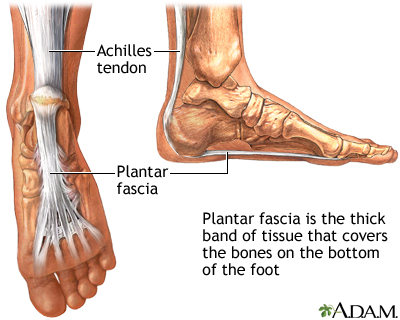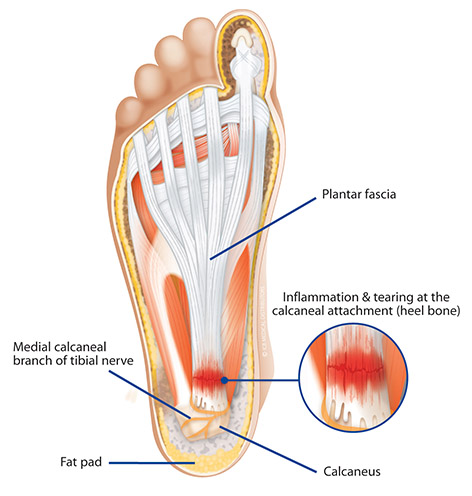Plantar Fascia Surgery in New Jersey
The Foot & Ankle Center
at Modern Orthopedics of New Jersey
Paramus
72 Route 17 North
Paramus, NJ 07652
Wayne
2025 Hamburg Turnpike
STE C, Wayne, NJ 07470
Parsippany
3799 US-46
#207, Parsippany, NJ 07054
Understanding Plantar Fasciitis
Plantar fasciitis is an inflammatory process which is triggered by tearing of your plantar fascia, more correctly described as the plantar aponeurosis. It is, the majority of the time, secondary due to a tight Achilles tendon, which exerts force onto the heel bone, which in turn holds the plantar fascia taut. When that tearing of the fascia takes place, it leads to inflammation, pain, and swelling. In some instances, when patients have this become a chronic issue, their body tries to compensate by lengthening out the heel bone, referred to as a heel spur. By doing so, the body is attempting to alleviate some of the tension experienced in the heel. A common misconception is that the pain in the heel originates from the heel spur; this is not so, as it is actually the micro-tearing of the fascia and the inflammation secondary due to it that is the real culprit.
Anatomy of the Foot and Plantar Fascia


Symptoms of Plantar Fasciitis
Patients experiencing this commonly complain of sharp pain in their heel, which almost feels like a stabbing sensation. Most commonly, the first steps in the morning cause the most pain and generally get better over 20 minutes of walking in the morning. This would also occur when a patient stands up from sitting for an extended period of time. However, in more chronic conditions, the pain may persist throughout the day.
Diagnosing Plantar Fasciitis
In a vast majority of situations, a thorough clinical history and physical exam are very informative. Palpation of what is called the medial calcaneal tubercle is the most common physical exam finding of a patient with plantar fasciitis. Ankle range of motion examination also typically demonstrates limitations. Another symptom commonly observed is the inability to move one’s little toe outwards.
Diagnostic Methods and Criteria
Some valuable studies that are used to assess plantar fasciitis are plain film, X-rays, MRI, ultrasound, and diagnostic injections. An X-ray can visualize the presence of a plantar or posterior heel spur in cases of chronic plantar fasciitis. It can also rule out other conditions that mimic it, such as rheumatoid arthritis, calcaneal fracture (broken heel bone), or even a bone tumor.
An MRI can be used in order to assess the integrity of the plantar fascia, view any surrounding inflammation and assess the thickness of the fascia due to chronic changes. An MRI is also valuable in ruling out soft tissue masses and a specific nerve entrapment that presents on MRI as atrophy of a muscle that innervates the motion of your little toe, both of which look similar to plantar fasciitis.
Ultrasound is similar to MRI in that you can visualize the plantar fascia but with the added benefit of being able to see it in real time and be able to visualize its motion. It is valuable in that it can be used concomitantly with performing a diagnostic injection so that you can directly visualize the site you are injecting into.
When To Seek Medical Advice
It is very important to seek out medical attention when attempts at conservative therapy such as resting, icing, at-home stretching, and over-the-counter inserts have not alleviated the signs and symptoms. It is also indicated if signs and symptoms are worsening or if you notice any changes in your foot anatomy, particularly with your arches. An evaluation is also strongly recommended if you aren’t able to be mobile to perform your daily living and sports activities.
Plantar Fascia Surgery at Modern Orthopaedics
Overview of Plantar Fascia Procedure
There are many different forms of plantar fascia surgeries available. The most commonly performed is the EPF, which is short for endoscopic plantar fascia release. Another very commonly performed procedure to treat plantar fasciitis is a plantar fasciectomy with the removal of the bone spur. An indirect yet very effective treatment for plantar fascia is referred to as a gastrocnemius recession.
Why Choose Modern Orthopaedics for Your Surgery?
At Modern Orthopaedics, you will receive world-class Foot & Ankle care from an incredibly experienced group of surgeons who will provide treatments tailor-made for your needs!
Treatment Options for Plantar Fasciitis
Non-Surgical Treatments
A very valuable non-operative treatment is referred to as shockwave therapy. This is a high-intensity machine used to interrupt damaged tissue through microtrauma, promote healing and, most importantly, decrease pain. The treatments are performed in 3-6 sessions. After the last session, noticeable improvement/resolution of signs and symptoms is expected within the month. Another important non-operative treatment for plantar fasciitis is daily, consistent stretching. This is often done through the education and guidance of an experienced physical therapist.
Surgical Options:
EPF
The most commonly performed is the EPF, this is short for endoscopic plantar fascia release. This procedure is performed using a camera and a cutting instrument. Through camera visualization, a portion of the plantar fascia is cut and freed.
Plantar Fasciectomy With Bone Spur Removal
Another very commonly performed procedure to treat plantar fasciitis is a plantar fasciectomy with the removal of the bone spur. This is a mini-open procedure which is composed of a small incision, and through direct visualization, the problemed portion of the plantar fascia is removed. This is followed by cleaning up the bone spur.
Gastrocnemius Recession
An indirect yet very effective treatment for plantar fascia is referred to as a gastrocnemius recession. This procedure is also performed through a mini-open technique, allows for direct visualization of a thin, soft tissue structure overlying your calf muscle, and is subsequently cut in a gentle fashion. This leads to an improved range of motion at the ankle joint and takes off a substantial amount of tension on the plantar fascia. This aids in patients’ daily stretching and physical therapy as a whole.
Rehabilitation and Recovery After Plantar Fascia Surgery
Post-Operative Care for Plantar Fascia Surgery
The three forms of plantar fascia surgery discussed have very minimal downtime. They are all same-day surgery performed on an outpatient basis. You will return to walking on the day of surgery in a special shoe or boot. The surgical dressing will be required to be kept clean, dry, and intact until a follow-up visit. It is very helpful to elevate the foot and to take pain medication in the initial period following surgery.
Long-Term Recovery and Rehabilitation Plans
After 2-3 weeks or so, the shoe/boot will be discontinued, and you will return to walking in a sneaker. In some instances, a short course of physical therapy may be required, but in many others, a gradual return to activities is tolerated well within the end of the month of surgery.




A Different Orthopedic Experience.
We combine cutting-edge technology with personalized care to deliver exceptional orthopedic treatment. Our team of experts focuses on your unique needs to ensure optimal outcomes and a superior healing experience.
Our Approach to Care
Comprehensive solutions for your orthopedic needs
Treatment Diversity
We offer a comprehensive range of treatments, ensuring personalized, targeted plans for every patient.
Technological Excellence
We utilize cutting-edge technology for precise diagnosis and innovative treatment options.
Collaborative Care
Our multi-disciplinary approach involves various specialties to provide comprehensive care and recovery.
Skilled Experts
Our team is composed of highly skilled, experienced orthopedic professionals, providing expert care.
Patient Focus
We prioritize patient comfort and satisfaction, creating a supportive environment for optimal healing.
Post-Treatment Support
Our robust post-treatment support ensures ongoing patient care through recovery and rehabilitation services.